Mastering Diamond Clarity: A Comprehensive Guide
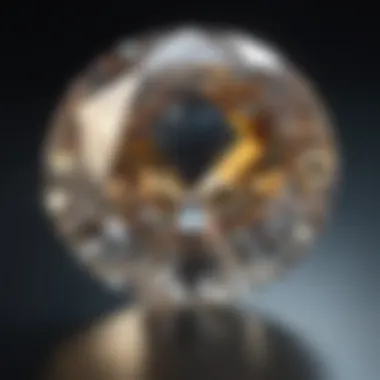
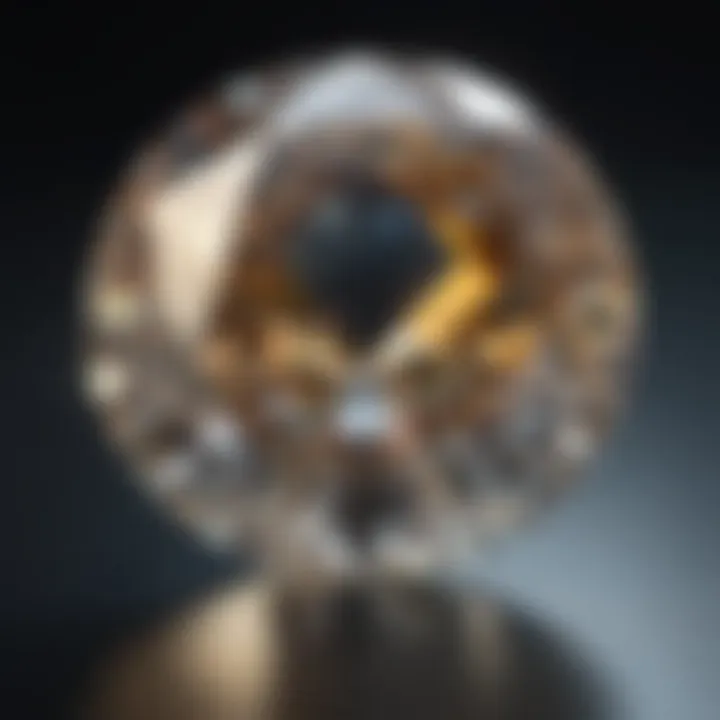
Intro
Diamonds have fascinated humanity for centuries, their allure transcending cultural and geographical boundaries. The beauty of these gemstones, however, is far more than surface deep. One critical aspect that often goes overlooked by those unfamiliar with the gemological world is diamond clarity ranking. This ranking is not merely a descriptor; it serves as a guide through the intricacies of what makes a diamond valuable and appealing to the eye. Understanding diamond clarity can illuminate choices for collectors, jewelry designers, and enthusiasts alike, turning what seems a simple decision into a well-informed investment.
In the forthcoming sections, we will delve into the dimensions of clarity, examining how inclusions and blemishes are evaluated, and their implications on a diamond's overall quality. From the historical significance of diamonds to their physical properties, a comprehensive exploration awaits.
Gemstone Overview
Definition and Origins
Diamonds are a form of carbon that crystallizes under extreme pressure and temperature. This natural phenomenon results in a hard substance, renowned not only for its strength but also its stunning beauty. Formed deep within the Earth’s mantle over the course of millions of years, diamonds journey to the surface through volcanic eruptions. Today, they are mined from numerous locations, including South Africa, Russia, and Canada, with each site contributing distinct characteristics to the diamonds extracted.
Historical Significance
The journey of diamonds through history is as captivating as the stones themselves. Initially prized in ancient India, they were believed to possess protective virtues. Over centuries, their rarity and beauty established diamonds as symbols of wealth and status across cultures. Notably, during the Middle Ages, they became associated with invincibility, a belief rooted in the stone’s indestructibility. Their allure has only grown, culminating in modern times where diamond engagement rings have become a staple in celebrations of love and commitment.
"A diamond is forever." This slogan from the mid-20th century cemented the stone's place not just in jewelry but in emotional narratives as well.
Gemstone Properties
Hardness and Durability
Diamonds stand unrivaled when it comes to hardness, rated a perfect 10 on the Mohs scale. This attribute contributes immensely to their durability, making them suitable not just for adornment but practical uses as well, such as cutting tools. The robust nature of diamonds ensures that, with proper care, they will endure through time, becoming heirlooms passed from generation to generation.
Color and Clarity
While clarity primarily centers around the presence of inclusions and blemishes, it affects how light interacts with the diamond as well, influencing its brilliance and sparkle. Color, on the other hand, refers to the degree of hue present in a diamond. Ranging from colorless to shades of yellow or brown, color impacts clarity's perceived quality, as less color can enhance a diamond's overall beauty.
When assessing diamonds, clarity is organized into specific grades, such as Flawless, Internally Flawless, VVS1, and so forth, with each grade carrying significant weight in terms of value and desirability. Diamond clarity not only informs jewelers and collectors about quality but also fuels a broader market of gemstone enthusiasts eager to expand their collections.
Through this journey of discovery, the significance of diamond clarity emerges not just as a measure of quality but a gateway to understanding the entire essence of these remarkable gemstones.
Overview of Diamond Clarity
When it comes to gemstones, particularly diamonds, clarity holds a crucial place in the hierarchy of attributes that define a stone's quality. In the realm of diamond grading, clarity refers to the absence of inclusions and blemishes, which can significantly impact both the aesthetic appeal and market value of a diamond. The clarity ranking helps distinguish the diverse grades of diamonds, allowing buyers and collectors to make informed decisions.
Understanding clarity isn’t just important for valuation; it also informs the overall brilliance and sparkle of the diamond. A clearer diamond allows light to pass through more efficiently, resulting in a more dazzling appearance. Furthermore, recognizing clarity helps enthusiasts appreciate the uniqueness of each gemstone. After all, two diamonds can look similar, while their grading could tell an entirely different story regarding their value.
In this section, we will explore two crucial components of clarity: its definition and its importance in diamond grading. By breaking these down, it becomes easier to grasp why clarity not only enhances the beauty of a diamond but also elevates its standing in the market.
Definition of Clarity
Clarity is not merely a subjective measure but rather a standardized definition within the gemological community. It refers to the presence of internal characteristics, known as inclusions, and external marks termed blemishes.
- Inclusions: These are internal flaws, like tiny crystals or gas bubbles, that are trapped during the diamond formation process. Though they can come in various shapes and sizes, their visibility directly affects grading.
- Blemishes: These are marks on the surface of a diamond that detract from its purity. They can include scratches, nicks, or polish lines.
The Gemological Institute of America (GIA) and several other gemological authority institutions have established a clarity scale ranging from Flawless (F) to Included (I). A Flawless diamond, while exceedingly rare, offers a pristine, unobstructed view of its beauty, while an Included diamond may possess obvious imperfections that can be seen without magnification.
Importance in Diamond Grading
Diamond clarity plays an essential role in the grading process for several reasons. First and foremost, it directly influences a diamond's market value. In a market flooded with diverse options, a diamond's clarity can very well be the differentiator between a few hundred and thousands of dollars. A diamond that ranks high on the clarity scale often commands a higher price due to its rarity and desirability.
Moreover, clarity interacts closely with other facets of a diamond, including its cut and color. For example, a beautifully cut diamond can enhance a lower-clarity stone's perception, yet buyers often seek the best clarity they can afford because of its impact on brilliance and scintillation.
In addition to valuation and aesthetic allure, clear diamonds are often associated with better craftsmanship. Recognizing the significance of clarity aids buyers in their hunt for high-quality pieces that are not just beautiful but also represent superior gemological standards.
"A diamond's clarity is the window through which its beauty shines. Understanding this aspect can lead to truly exceptional choices."
In summary, having a solid grasp on diamond clarity is indispensable for anyone venturing into the market, be it for personal adornment or collecting purposes. Decoding clarity ensures connoisseurs and casual buyers alike can appreciate the depth of their investment, enrich their understanding, and engage meaningfully with their choices.
The Clarity Scale
Understanding the clarity scale is crucial when it comes to assessing a diamond's overall quality and value. In the world of gemstones, clarity refers to the presence of inclusions and blemishes, which can greatly impact both the appearance and desirability of a diamond. The clarity scale provides a systematic way to evaluate these characteristics, enabling buyers and collectors to make informed decisions.
A well-defined clarity scale allows for sharper differentiation between diamonds. This means that as a buyer, you can navigate the vast options available with more precision. Each grade on the scale not only reflects a diamond's internal makeup but also contributes to its market value. Knowing where a particular diamond falls on this scale can help you appreciate its uniqueness and understand its price.
Moreover, the clarity scale serves as a benchmark for communication among dealers, gemologists, and consumers alike. When everyone understands these classifications, misunderstandings diminish, ensuring clearer conversations when discussing quality and pricing.
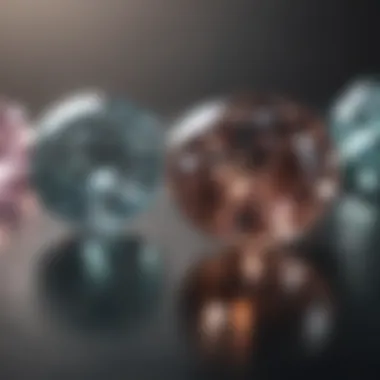

"A diamond's clarity grade can speak volumes about its worth, and knowing the clarity scale is half the battle to finding a gem that truly shines."
Understanding Clarity Grades
The clarity grades range from Flawless (F) to Included (I3), each category representing a specific level of inclusions and blemishes visible under 10x magnification. Here’s a simplified breakdown:
- Flawless (F): No inclusions or blemishes visible at 10x magnification.
- Internally Flawless (IF): No inclusions visible, but minor blemishes may be present on the surface.
- Very Very Slightly Included (VVSI): Inclusions difficult to detect under 10x magnification; usually only visible to experienced gemologists.
- Very Slightly Included (VSI): Small inclusions visible under 10x but not easily noticeable to the naked eye.
- Slightly Included (SI): Inclusions noticeable under 10x magnification and may be visible to the naked eye depending on the size and location.
- Included (I): Significant inclusions or blemishes visible to the naked eye, often impacting appearance.
This careful classification helps buyers gauge which diamonds may appeal to them. A lower clarity grade could mean a lower price but may also have visible flaws that detract from its beauty.
Key Terms and Definitions
When delving into the clarity scale, it's helpful to familiarize yourself with specific terms that repeatedly appear in this context:
- Inclusion: Any internal flaw (like a bubble or a mineral crystal) present in the diamond.
- Blemish: Any external flaw (like scratches or nicks) that could mar the diamond's surface.
- Eye-Clean: A term used to describe a diamond that doesn’t have any inclusions visible to the naked eye.
- Loupe: A small magnifying lens used by jewelers to examine a diamond's clarity more closely.
Understanding these terms enhances your ability to discuss and navigate the complexities of diamond clarity effectively. Engaging with these definitions gives you an edge in finding the ideal stone, whether it's for personal use or investment.
Major Clarity Grades Explained
Understanding the major clarity grades is essential for anyone diving into the world of diamonds. This segment sheds light on how each grade impacts the diamond's value and desirability. Not only does it clarify terminology for buyers, but it also provides insight into what to look for when shopping. A diamond's clarity can significantly influence its brilliance and overall appeal, so grasping these grades equips any collector or enthusiast with the knowledge needed to make informed decisions.
Flawless Diamonds
Flawless diamonds, noted as having no inclusions or blemishes visible under 10x magnification, represent the pinnacle of clarity. These gems are a rarity, and their existence is as rare as hen's teeth. It’s no wonder that they come with a hefty price tag. Many enthusiasts dream of owning one, not just for its beauty but also for the prestige attached to having a flawless stone.
"Flawless diamonds aren't simply perfect; they echo a deep commitment to nature's artistry."
Such diamonds possess a superior level of brilliance, allowing light to dance within the stone without hindrance. To the connoisseur, a flawless diamond is not just a purchase; it’s an investment in something timeless.
Internally Flawless
Internally flawless diamonds may have minute surface blemishes but are devoid of internal inclusions. This means even under 10x magnification, the inclusions will not cause concern for the potential buyer. This grade offers an excellent balance; it retains stunning visual appeal while often being a tad more accessible than its flawless counterpart. For those who appreciate perfection but still need to keep an eye on their budget, this grade strikes a lovely middle ground.
Very Very Slightly Included
Very very slightly included diamonds, abbreviated as VVS, are like diamonds with a hidden agenda. The inclusions present are so minor that only skilled professionals can detect them under magnification. These diamonds offer another layer of luxury without the exorbitant price tag that comes with flawless stones. For many collectors, a VVS diamond represents a beautiful synthesis of quality and affordability.
Very Slightly Included
Very slightly included diamonds, or VS, feature inclusions that might be visible to a trained eye but generally remain hidden to the untrained observer. This category highlights the delicate balance between visibility and allure. Consumers might opt for VS stones for their approachable price points while still reaping significant visual payoff. It’s often the choice of jewelry designers who wish to offer quality without overwhelming their clients' wallets.
Slightly Included
Slightly included diamonds are those where the inclusions are noticeable without magnification but remain the choice for many due to their lower prices. A savvy shopper can find a balance of beauty and investment in this tier. While these diamonds might not boast perfection, they often still glisten wonderfully when placed in the right setting, offering charm and character that polished stones sometimes lack.
Included
This grade signifies diamonds with inclusions that are easily visible without any magnification. While these diamonds might be shunned by some, they often come with price points that are incredibly appealing. For many, included diamonds can tell a story; each inclusion reveals a piece of the stone's journey through nature. These stones often serve well in casual jewelry or as individual pieces in bespoke creations.
Understanding these clarity grades enrich tones across the entire spectrum of diamond appreciation. Knowing how each category correlates with characteristics such as sparkle and market value lays a strong foundation for anyone looking to invest wisely in these stunning natural wonders.
Factors Affecting Diamond Clarity
Understanding the factors that influence diamond clarity is essential for anyone serious about purchasing or evaluating diamonds. Clarity plays a pivotal role in determining a diamond's overall appearance and value, thus making it crucial for buyers, collectors, and even professionals in the jewelry industry to grasp these factors.
When assessing clarity, there are two main elements to consider: natural inclusions and blemishes that occur during the diamond's formation and the clarity enhancement techniques that can be employed after the diamond has been created. Each of these factors contributes to how a diamond looks and its perceived worth.
Natural Inclusions and Blemishes
Natural inclusions and blemishes refer to the internal and external imperfections that occur naturally as a diamond forms over millions of years under high-pressure and high-temperature conditions.
Inclusions:
Inclusions are internal issues, such as tiny crystals, gas bubbles, or other minerals that get trapped within the diamond. These can significantly affect clarity. Examples include:
- Feathers: These give a wispy appearance and can diminish sparkle.
- Crystals: Some diamonds have other minerals embedded within them, which can be intriguing but may also detract from clarity.
Blemishes:


Blemishes, on the other hand, are visible on the diamond's surface, such as scratches, nicks, or pits. Their impact on clarity can often be less significant than inclusions, but they still matter:
- Surface Graining: A line or streak on the surface that can affect the visual appeal.
- Scratches: These can be surface-level but may catch light, impacting overall brilliance.
Both inclusions and blemishes are crucial in determining how a diamond is graded in terms of clarity. Jewelers and gemologists look closely at these characteristics, often utilizing magnification tools to identify and assess them.
"The fewer the inclusions and blemishes, the higher value a diamond generally commands, making these aspects indispensable in the grading process."
Clarity Enhancement Techniques
As the market evolves, some diamonds undergo treatments to enhance their clarity. These clarity enhancement techniques aim to improve the appearance of imperfections, making diamonds more appealing to buyers. However, understanding these methods is vital because they can affect the stone's worth and marketability.
Here are some common techniques:
- Laser Drilling: This method involves using a laser to remove inclusions from the diamond. It leaves a small tunnel behind but can significantly enhance clarity.
- Fracture Filling: This technique fills surface cracks or inclusions with a transparent substance to make them less visible. While it improves clarity, it can also alter how light interacts with the diamond.
- High-Pressure High-Temperature (HPHT) Treatment: This is a more advanced technique used to change the diamond’s color and clarity by mimicking natural diamond-forming conditions.
Understanding how these treatments impact a diamond can guide buyers in making informed decisions. While enhanced diamonds can be beautiful and cost-effective, they might not hold the same long-term value as their untreated counterparts.
In summary, grasping the factors affecting diamond clarity, from natural inclusions and blemishes to clarity enhancement techniques, provides crucial insights for anyone in the diamond industry or market. These elements play a fundamental role in determining a diamond's beauty and value.
Evaluating Clarity in Practice
Understanding diamond clarity requires more than just knowing the definitions and grades. To truly grasp how clarity impacts value and appearance, one must delve into the practical aspects of evaluation. This section articulates the significance of evaluating clarity by highlighting the tools and professional processes that ensure an accurate assessment of diamonds. The ability to discern subtle differences in clarity can make a significant difference in the diamond’s worth, leading both collectors and buyers towards informed decisions.
Tools Used for Clarity Assessment
Magnification Techniques
Magnification techniques play an essential role in evaluating diamond clarity. Using tools like Jeweler’s loupes or microscopes, professionals can closely inspect the stone for inclusions and blemishes that are often invisible to the naked eye. The key characteristic of magnification is its ability to provide a detailed view of the diamond’s internal and external features.
This method is a popular choice because it allows for precise analysis. While microscopes offer advanced viewing capabilities, the jeweler’s loupe is more portable and user-friendly for quick inspections. However, one might encounter some disadvantages; for instance, using high magnification can sometimes lead to misinterpretation of a diamond's apparent clarity due to optical illusions created by the lens.
Light Reflection Studies
Light reflection studies reveal how a diamond interacts with light, which can significantly affect its perceived clarity. This method involves analyzing the way light enters the diamond and reflects back, emphasizing clarity and brilliance. Light reflection studies evaluate not only the presence of inclusions but also how they impact the way light behaves within the stone.
The primary advantage of this technique is that it provides insights into how the diamond will appear to the naked eye under different lighting conditions. However, the drawback is that it can be more complex to perform and requires specific setups to yield accurate results. The unique feature of light reflection studies is that they emphasize the gem’s visual performance rather than just cataloging imperfections.
Professional Grading Processes
Grading Laboratories
Grading laboratories serve as central pillars in the diamond evaluation process. These institutions, equipped with expert evaluators and sophisticated tools, assess diamonds according to standard grading practices. The hallmark of grading laboratories is their systematic approach to determining a diamond's clarity, ensuring consistency and credibility.
One significant benefit of using accredited grading labs is the assurance of unbiased evaluations, which can bolster the diamond’s resale value. Notably, each lab has its own nuances, and some may prioritize certain clarity aspects over others, introducing variability. This means that not all grading is created equal, and it is crucial to choose reputable labs to ensure reliable results.
Grading Reports
Grading reports provide a detailed account of a diamond’s characteristics, including its clarity grade. These documents serve as a promise of transparency and trust for buyers and sellers. A well-prepared grading report typically highlights key aspects of the stone, including a comprehensive description of inclusions and any measurements relevant to the clarity assessment.
Additionally, grading reports are vital for resale purposes; they can enhance the diamond's marketability by offering buyers an in-depth understanding of what they are purchasing. However, potential downsides include variability in grading standards among laboratories, which can lead to confusion if not carefully interpreted.
In summary, understanding the tools and processes behind clarity evaluation is fundamental for anyone serious about diamonds.
Through the combination of magnification techniques and light reflection studies, alongside the rigorous processes employed by grading laboratories and comprehensive grading reports, you can navigate the intricate world of diamond clarity with a well-informed perspective.
The Impact of Clarity on Value
When it comes to diamonds, clarity plays a pivotal role in determining their overall value. Clarity, which refers to the presence of inclusions and blemishes within or on the surface of a diamond, directly impacts not just the stone's beauty but also its market price. A clear diamond with few or no visible imperfections will often fetch a higher price than one with noticeable flaws.
This importance stems from several key elements that buyers and collectors should consider:
- Aesthetic Appeal: The visibility of inclusions can diminish the brilliance and sparkle that diamonds are known for. Higher clarity grades often correspond with increased light return and overall scintillation, making these stones more visually appealing.
- Market Demand: Trends in consumer preferences tend to lean toward clarity, especially for engagement rings. Buyers typically seek stones that are perceived as flawless or nearly flawless for significant purchases, influencing market trends and prices.
- Investment Value: Unlike other markers of quality, such as cut or color, clarity can significantly affect resale value. Collectors seeking investment-grade stones often prioritize clarity, as these diamonds are more likely to maintain or appreciate in value over time.
In essence, clarity is not merely a component of grading; it is a cornerstone of a diamond's market identity, shaping its desirability and valuation.
Market Trends in Diamond Sales
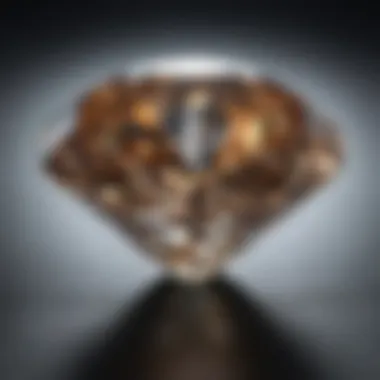
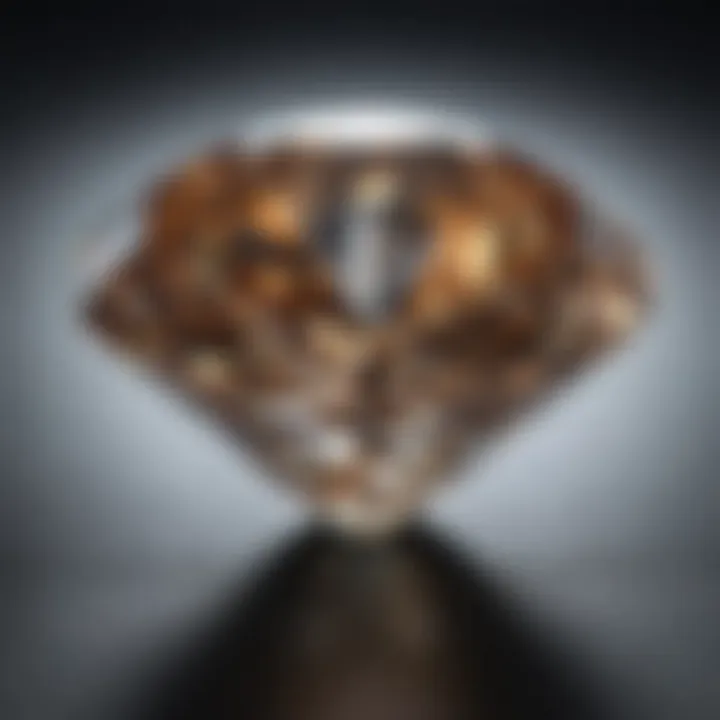
Analyzing market trends in diamond sales reveals intriguing insights regarding clarity. Over the years, sales data suggests a clear correlation between diamond clarity and price fluctuations. For instance, historically, stones rated as Flawless or Internally Flawless have commanded prices that significantly surpass those of lower-clarity stones.
This relationship is influenced by various factors:
- Luxury vs. Affordability: As the luxury market evolves, more consumers seek out high-end quality, pushing demand for higher clarity diamonds. Conversely, there are also sections of the market where buyers are increasingly turning to more affordable options that may have lower clarity grades but offer good value in other aspects like cut.
- Online Retail Growth: The rise of e-commerce has democratized access to diamond purchasing. Now buyers can effortlessly compare clarity levels and prices across various retailers, which can drive prices up for high-clarity options.
- Cultural Shifts: Emerging trends, reflecting generational shifts in consumer behavior, have introduced a nuanced approach to diamond purchases. Millennials and Gen Z, for example, are more inclined to seek ethical sourcing along with clarity, impacting demand dynamics and sales strategies accordingly.
In summation, the influence of clarity on market trends cannot be overstated. It dictates not only individual sales but also the flow of the diamond market, shaping how diamonds are perceived in both luxury and everyday contexts.
Consumer Preferences and Clarity
Consumer preferences heavily influence the impact of clarity on diamond value. Today's buyers often prioritize clarity when selecting a diamond, making it a critical factor in their decision-making process. Several aspects are worth noting:
- Educational Resources: Increasingly, consumers are informed about diamond grading. Access to educational material has made them more discerning. Many buyers actively seek stones that boast high clarity grades, having learned about the significance of these inclusions and blemishes.
- Visual Preference: When it comes to choosing a diamond that stands out, clarity ranks high. Shoppers often gravitate toward stones that exhibit fewer visible flaws, as these choices are associated with luxury and exclusivity. from engagement rings to investment pieces, visibility plays a crucial role.
- Emotional Value: For many buyers, diamond purchases are often linked to significant life events. When selecting a stone meant to symbolize commitment or love, clarity can hold sentimental weight. A clear diamond may feel more special, accentuating emotions tied to important moments in life.
Overall, consumer preferences regarding clarity reflect a blend of informed choices with emotional resonance. Understanding how clarity interacts with market demands can equip buyers with valuable insights, ultimately leading to more satisfying and meaningful purchases.
Clarity versus Other Factors
When diving into the intricate world of diamonds, clarity doesn't exist in a vacuum. It's important to understand how it interacts with other key characteristics, particularly cut, carat, and color. Each of these factors contributes to the overall allure and value of a diamond, making their interplay critical for both enthusiasts and collectors alike.
The Role of Cut and Carat
The diamond's cut shape and quality deeply influence its brilliance and overall appearance. While clarity focuses on internal and external features, the cut determines how light enters and reflects out of the stone. A well-cut diamond can appear much more brilliant, even if it has slight clarity issues. For example, a round brilliant cut can mask minor inclusions through its sparkle, captivating the observer's eye.
In terms of carat, this unit of weight significantly alters a diamond's perception and demand. A higher carat weight often correlates with larger size, which inherently holds more visual importance than its clarity. However, a small, exceptionally clear diamond can sometimes outshine a larger, lower-clarity stone. This is where it gets tricky: balancing weight and clarity may seem like trying to hit a moving target.
Color Grade Interaction
Color is another essential facet that dances with clarity in shaping a diamond's allure. A clear diamond with a touch of yellow may not be as desirable as a slightly included one that sits in a higher color grade. The hues and tonal variations can affect how inclusions present themselves to the naked eye. In many cases, a diamond can seem flawless due to its deep, rich color, even if it contains minor inclusions.
"The human eye often prioritizes striking color over minimal clarity issues."
Understanding color interaction shapes decision-making for collectors looking for specific aesthetic qualities. Whether considering a white diamond or one with a fancy hue, the visual impact may outweigh slight clarity blemishes. This mutual influence among clarity, cut, carat, and color creates a layered narrative in the diamond's world, revealing that no single attribute reigns supreme—it’s all about finding the right balance.
Common Misconceptions about Diamond Clarity
Understanding the intricacies of diamond clarity is critical for anyone serious about investing in or collecting gemstones. However, several misconceptions about clarity often lead to flawed judgments. Recognizing these myths is essential as it helps buyers make informed choices and appreciate their purchases fully. Many believe clarity is the sole determinant of a diamond's quality, which diminishes the importance of other aspects like cut and color.
Flawless Does Not Mean Perfect
A common misunderstanding among gem lovers is equating a "flawless" diamond with a flawless experience or a perfect stone. In essence, while a flawless diamond is certainly luxurious and appealing, it does not guarantee other dimensions of perfection. The term "flawless" refers strictly to the absence of inclusions and blemishes visible under 10x magnification, as per the grading systems. However, this does not necessarily reflect how the diamond appears to the naked eye or even how it interacts with light.
For example, a diamond might be graded as flawless, but its cut might not be ideal, leading to poor light performance. Also, the overall aesthetic may not align with personal tastes, as beauty is subjective and depends on individual preferences. In fact, some collectors appreciate character in their stones; slight inclusions can tell a story about the diamond's journey through time.
"A flawless diamond doesn’t mean it resonates perfectly with everyone’s eyes or hearts."
Value Misunderstandings
Another area of confusion centers around the value associated with diamond clarity. The perception that higher clarity always correlates with higher monetary value can lead collectors astray. While clarity undoubtedly affects pricing, it is not the only factor.
- Market Demand: The current market trends play a significant role in a diamond's value. For instance, a slight dip in the popularity of higher clarity diamonds could shift their market price.
- Other Grading Factors: As mentioned earlier, cut and color also impact value significantly. A diamond with a mid-range clarity grade can fetch a higher price if it possesses an exceptional cut or color.
- Personal Preference: Ultimately, the buyer's personal preference can determine how much they are willing to pay. In some cases, stones with slight inclusions can be just as desirable, if not more so, depending on aesthetic appeal and buyer sentiment.
Thus, understanding that value is not purely derived from clarity but from a combination of elements helps collectors approach their purchases with a more holistic mindset.
The Future of Diamond Clarity Grading
The journey of diamond clarity grading is far from static; it's a path marked by advances in technology and shifts in consumer behavior. As we gaze into the crystal ball of diamond grading, understanding its future can provide insights for gemstone enthusiasts, collectors, jewelry designers, and geology aficionados. The relentless quest for greater accuracy, transparency, and personalization in diamond grades is not just a trend—it's a wave that is reshaping the industry.
Technological Advances
Technology is at the forefront of revolutionizing how diamonds are graded. Innovations in imaging and inspection technologies are enhancing the precision of clarity assessments. Techniques like high-definition imaging, computerized tomography, and even artificial intelligence are stepping in where traditional methods might fall short.
- High-Definition Imaging: This method captures minute details of a diamond's surface, enabling graders to identify inclusions that might remain hidden to the naked eye.
- Computerized Tomography: This allows for a thorough internal evaluation of the diamond. Instead of relying solely on external inspections, internal flaws can be documented with unprecedented clarity.
- Artificial Intelligence: AI is being employed to analyze images of diamonds, producing an effective grading help that reduces human error and bias.
These advancements not only refine clarity rankings but also promise to build trust among consumers. As technology continues to permeate the grading process, expect to see a significant increase in the accuracy and consistency of clarity assessments. The future points towards a more informed consumer base and possibly, a new standard in diamond grading.
Evolving Consumer Preferences
In tandem with technological innovations, consumer preferences in the diamond market are becoming more complex. Today's buyers are increasingly informed and discerning, which means they not only seek quality but also crave transparency.
- Demand for Transparency: Shoppers want to understand exactly what they are purchasing—where the diamond comes from, how it was graded, and what implications those grades have on value. More detailed grading reports, including specific clarity details, are becoming increasingly expected.
- Personalization in Grading: With a market leaning towards unique and custom pieces, clients desire diamonds that tell a story. Clarity grading that factors in personal taste and intended use is gaining traction.
- Sustainability Matters: There's a growing inclination toward sustainable and ethically-sourced diamonds. Clarity grades that incorporate the origins and the grading sustainability can significantly influence purchasing decisions moving forward.
"The future of diamond clarity doesn’t rest solely on the jewels themselves but also roots in the ethos of the market. Understanding how technology and personal values intertwine will shape our choices."
In summary, the prospect of diamond clarity grading is bright yet complex, driven by innovation and evolving consumer expectations. Understanding these dynamics will be vital for anyone involved in the diamond sector. As we move ahead, the fusion of technology and personal values is likely to redefine luxury and quality in the realms of gemstone collection and jewelry design.



